- Home
- Volume 29 (2025)
- Numéro 4
- Incorporating biochar from date palm residues improves barley yield and soil health in a pot experiment under controlled arid conditions
View(s): 0 (0 ULiège)
Download(s): 0 (0 ULiège)
Incorporating biochar from date palm residues improves barley yield and soil health in a pot experiment under controlled arid conditions

Attached document(s)
original pdf fileRésumé
Incorporer du biochar à partir de résidus de palmier dattier améliore le rendement en orge et la santé du sol dans une expérience en pot dans des conditions arides contrôlées
Description du sujet. Ce travail de recherche se concentre sur la valorisation agronomique des débris de palmier dattier dans les oasis du Sud-Est marocain, en particulier à travers l'utilisation du biochar dérivé pour améliorer la santé des sols et la production agricole.
Objectifs. L'étude vise à évaluer l'effet du biochar, dérivé des palmes sèches pyrolysées à 400 °C, sur les propriétés physico-chimiques d'un sol sableux et la production en biomasse de la variété d'orge Massine.
Méthode. Un essai d’amendement du sol en biochar a été conduit en pots comportant la culture de l’orge en plein champ. Le biochar du palmier dattier, ayant un taux de matière organique de 29,72 % et un pH de 8,24, a été incorporé dans le sol sableux à différents taux (1 %, 2,5 % et 5 %) en comparaison avec un sol non traité. L’évolution des propriétés du sol et la production en biomasse de l'orge ont été évaluées.
Résultats. L'amendement en biochar du sol a permis d’améliorer ses propriétés physico-chimiques, notamment le taux de matière organique, la conductivité électrique et la capacité d'échange cationique qui a augmenté de 51,4 % par rapport au groupe témoin. La capacité de rétention en eau du sol a également augmenté en fonction du taux de biochar, atteignant un maximum de 60 % à un taux d'incorporation de 5 %. Par ailleurs, la production de biomasse totale et de grains d'orge a augmenté respectivement de 80,41 % et 80 % à ce même taux, en comparaison avec le sol non amendé.
Conclusions. L’effet positif du biochar sur la santé du sol sableux et la culture de l’orge suggère que le biochar, produit à partir de débris de palmier dattier, pourrait constituer un amendement de choix pour améliorer la productivité agricole dans les oasis du Sud-Est marocain et améliorer la gestion des débris de palmier dattier au niveau du système oasien. Cette hypothèse devrait être confirmée par d’autres essais d’amendement des sols en biochar en milieu réel et couvrant les différentes conditions pédoclimatiques du système oasien.
Abstract
Description of the subject. This research focuses on the agronomic valorization of date palm debris in the oases of southeastern Morocco, particularly using biochar derived from this debris to improve soil health and agricultural production.
Objectives. The study aims to evaluate the effect of biochar, derived from dry palm fronds pyrolyzed at 400 °C, on the physicochemical properties of sandy soil and the biomass production of the Massine barley variety.
Method. A biochar soil amendment trial was conducted in pots featuring barley cultivation in open fields. Date palm biochar, with an organic matter content of 29.72% and a pH of 8.24, was incorporated into sandy soil at different rates (1%, 2.5%, and 5%) compared to an untreated control soil. The evolution of soil properties and the biomass production of barley were assessed.
Results. Soil amendment with biochar improved its physico-chemical properties, notably the organic matter content, electrical conductivity, and cation exchange capacity, which increased by 51.4% compared to the control. Soil water retention capacity also improved with increasing biochar rates, reaching a maximum of 60% at a 5% incorporation rate. Furthermore, total biomass and grain yield of barley increased by 80.41% and 80%, respectively, at this same rate, compared to the unamended soil.
Conclusions. The positive effect of biochar on sandy soil health and barley cultivation suggests that biochar produced from date palm debris could be a promising amendment to enhance agricultural productivity in the southeastern Moroccan oases and improve date palm debris management within the oasis system. This hypothesis should be confirmed by further biochar amendment trials conducted under field conditions and encompassing the diverse pedoclimatic contexts of the oasis system.
Table of content
Received 24 September 2024, accepted 3 July 2025, available online 16 September 2025.
This article is distributed under the terms and conditions of the CC-BY License (http://creativecommons.org/licenses/by/4.0)
1. Introduction
1Semi-arid and arid regions, characterized by evaporation greatly exceeding precipitation, cover approximately 47.2% of the Earth's surface (Lal, 2004). Most soils in arid areas are considered poorly suited for agriculture due to their coarse texture (Jimin et al., 1998), low water and nutrient retention capacity (Van Asperen et al., 2014) and low organic carbon content (Lal, 2004). Oases, although accounting for less than 3% of these regions, support between 7 and 10 million people (Clouet, 1995). In Tafilalet, located in southeastern Morocco, oases cover 28,870 ha and are home to more than 2.3 million date palms, sustaining a significant population (ORMVA-TF, 2023).
2Arid and semi-arid zones face rising global temperatures and increased aridity due to climate change (CC) (Karbout et al., 2019). At the local level, the oases of Tafilalet are no exception, experiencing the effects of CC and other environmental issues caused by the accumulation of date palm debris. In fact, date palm cultivation in the Tafilalet oases generates 52,400 tons of debris annually, 62% of which is either abandoned in the oases or burned (Khardi et al., 2024). The accumulation of this debris leads to the spread of fungal diseases (Fusarium oxysporum f.s Albendenis), the proliferation of date palm pests and the outbreak of palm grove fires (Khardi et al., 2024). Burning these residues pollutes the atmosphere, reduces soil nutrients and microbial populations, and presents risks to human health and the environment (Burezq et al., 2023). Soils in the Tafilalet oases also exhibit particularly low levels of organic matter (El Janati et al., 2021).
3To promote sustainable and resilient agriculture in these areas, it is crucial to adopt new methods to improve soil properties and moisture conservation. Soil aggregation is a key factor in this process, and the addition of organic carbon can enhance soil aggregation as well as its physical and chemical properties (Fallahzade & Hajabbasi, 2012). Farmers apply manure and inorganic fertilizers to improve crop productivity. However, these practices can lead to soil degradation and various environmental problems associated with the mineralization of organic matter (Agegnehu et al., 2017).
4In Tafilalet, only about 0.2% (2,620 tons) of the date palm debris generated is returned to the soil as green manure or compost (Khardi et al., 2024). However, the repeated use of such organic amendments at high rates is neither economically viable nor environmentally friendly due to the increase in CO2 emissions (Al-Wabel et al., 2019). These organic materials decompose rapidly in semi-arid and arid climates, releasing high levels of carbon dioxide (CO2) into the atmosphere (Fearnside, 2000).
5Researchers have shown that recycling crop residues is crucial for maintaining soil fertility and increasing agricultural productivity (Bacyé et al., 2021). This also sustainably improves soil health in line with the United Nations' sustainable development goals (Xiong et al., 2022).
6To improve the management of date palm debris and contribute to the sustainability of oases, we explored recycling this debris into biochar, as agricultural residual biomass. Date palm debris is the main feedstock for biochar production through thermochemical conversion (Marinos et al., 2022). This material has been the subject of numerous studies due to its agricultural benefits, particularly in arid regions (Al-Shankiti & Gill, 2014; Karbout et al., 2019). Biochar is obtained by pyrolysis of biomass, particularly agricultural residues, under low-oxygen conditions (Cornelissen et al., 2016; Wang et al., 2017).
7This approach is particularly promising for the Tafilalet oases, where converting date palm debris into biochar could reduce the volume of this problematic debris, stabilize carbon in soils and mitigate greenhouse gas emissions (Wang et al., 2012). Numerous studies have shown that biochar improves the physical, chemical and biological properties of soils, thereby increasing crop yields (Pandit et al., 2018; Lompo et al., 2021). Additionally, the application of biochar in sandy soils increases organic carbon content (Busscher et al., 2010), water retention capacity (Kinney et al., 2012), and nutrient retention (Shafie et al., 2012).
8This research aims to enhance the valorization of date palm residues to strengthen the resilience of oasis agroecosystems. To achieve this, barley pot experiments were conducted in open-field conditions over a 6-month period for two campaigns 2022/2023 and 2023/2024. The main objective was to evaluate the effect of biochar derived from date palm residues on soil properties and barley productivity. A sandy soil was selected, characterized, and used as the experimental medium, while the produced biomass and biochar were also analyzed. The impact of biochar application was then assessed on the physico-chemical properties of the soil, as well as on barley yield and dry biomass production.
2. Materials and methods
2.1. Study area
9The soil amendment experiment, involving barley cultivation with biochar, was conducted in the open field on the farm located (coordinates X:599665.22; Y:150463.59) in southeastern Morocco.
10The soil used in this experiment was collected from a date palm cultivation plot located in the extension area of the palm grove. Sampling was conducted in the surface horizon (0-20 cm) of the inter-row space between the palm trees, within a small depression. This depression facilitated the accumulation of materials from both water and wind erosion. According to the farmer, this area was once naturally covered with jujube trees and had never received any fertilizer inputs.
11The soil belongs to the sandy soils of the semi-arid to arid regions of southeastern Morocco, which develop under extreme climatic conditions characterized by low water availability, irregular precipitation of less than 200 mm·year-1, and evapotranspiration exceeding 2,500 mm·year-1. Summer temperatures can exceed 40 °C, while winters remain relatively cool, with significant thermal variations between day and night. These conditions intensify water stress and influence soil formation and evolution. Soil samples from the study area were analyzed in a private laboratory in Meknes (Table 1).

2.2. Production of date palm biochar
12For the production of biochar, dry and complete fronds of the Aziza variety were cut into small pieces of 5 to 10 cm and sent to a private biochar production unit in Agadir, Morocco. This debris was pyrolyzed at a temperature of 400 °C and then ground before application. The biochar was produced using a Green Mad Retort 2 (GMDR) furnace (Temmerman et al., 2019).
13Operating principle of the GMDR carbonization furnace. The Green Mad Retort 2 furnace consists of six main components:
14– an external combustion chamber (Number 1 (N) in the figure 1);
15– a connection (pipes) between the combustion chamber and the carbonization chamber (N 2);
16– a carbonization chamber (between N 2 and N 5);
17– a combustion gas exhaust channel located beneath the carbonization chamber (N 3);
18– two chimneys: the first (N 4) connected to the combustion gas exhaust channel, and the second (N 6) connected to the carbonization chamber.
19The carbonization chamber and the combustion gas exhaust channel are separated by a metal sheet. Thermometers are used to measure the gas temperature at the top and bottom of the carbonization chamber, as well as in the chimney that evacuates gases from the carbonization chamber.
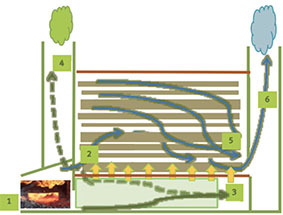
Figure 1. The GMDR 2 furnace — Le four GMDR 2.
Source : TEMMERMAN et al., 2019
20Carbonization process (pyrolysis). Once the furnace is loaded and sealed, the first step is to ignite a fire in the combustion chamber (N 1). The hot gases produced are directed into the exhaust channel (N 3), under the biomass load and towards the combustion gas exhaust chimney (N 4). This process heats the biomass load, causing the hot air within it to escape through the other chimney (N 6), which is connected to the carbonization chamber.
21A flow of air is thus generated in the carbonization chamber: hot air from the combustion chamber (N 2) enters the carbonization chamber, absorbs moisture released by the biomass and is then evacuated through the chimney connected to the carbonization chamber. This marks the drying phase, which lasts between 12 and 36 h, depending on the initial moisture content of the biomass. During this phase, the temperature does not exceed 100 °C. Once the biomass has lost its moisture, the temperature increases until it reaches carbonization levels (> 280 °C). The gases emitted during this phase are combustible. When the temperatures in the upper and lower parts of the furnace equalize, the exhaust chimney of the carbonization chamber is sealed off. The only escape way for the gases is then through the pipes connecting the carbonization chamber to the combustion chamber.
22Upon reaching the combustion chamber, the gases come into contact with air and ignite violently. This phase lasts between 3 and 6 h and concludes with full carbonization. At the end of this process, all air inlets are sealed, and the furnace is left to cool down for 3 to 4 days before unloading the produced biochar.
23The characterization of the biochar was conducted in an university laboratory (UM6P) in Ben Guerire, Morocco. The characteristics of the date palm biochar are detailed in table 2. The analysis of the biomass used was carried out in an Analysis and Quality Control Laboratory (Éléphant vert Maroc S.A., Meknès).
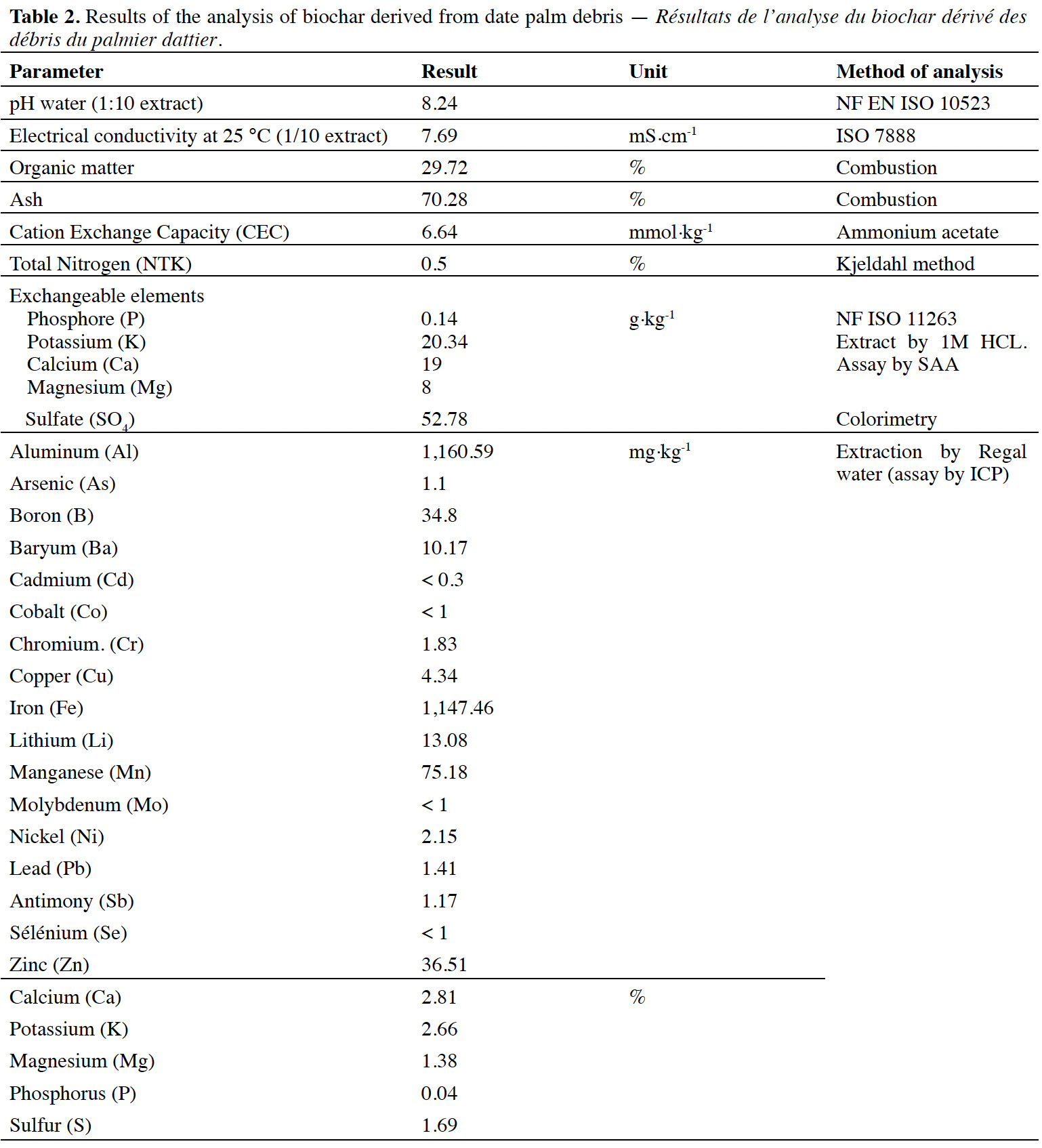
2.3. Plant material
24The plant material used in this study is the barley variety Massine, Generation R1 (Hordeum vulgare L.). It is a semi-early variety with high straw production, adapted to both irrigated and rain-fed cultivation methods.
2.4. Experimental setup
25The barley response to biochar amendment was tested in pots without the addition of fertilizers or amendments. The ground biochar was carefully mixed with sandy soil at four application rates: 0%, 1%, 2.5%, and 5% by weight. The selection of these biochar application rates was made to obtain results comparable to similar research studies and to identify an optimal amendment threshold. To this end, we referred to scientific literature, which indicates that application rates ranging from 0 to 5% are commonly used in soil amendment studies with biochars derived from various biomass sources (Lehmann & Joseph, 2015; Badawi, 2019). Additionally, a meta-analysis on the effects of biochar in agricultural soils suggests that application rates below 5% are frequently tested and have a significant impact on soil properties and crop yield (Jeffery et al., 2011).
26The buckets used (Figure 2a) were 20 cm high, with a top diameter of 23 cm and a base diameter of 16 cm, with 4 mm holes at the bottom. The soil-biochar mixture was hand-compacted, leaving a 15 mm freeboard for irrigation. Fifteen barley seeds were sown in each pot, corresponding to a sowing rate of 350 seeds·m-2 (1.33 qx·ha-1). After sowing, the pots were placed in the open field in a simple randomized block design with four treatments and ten replicates each, totaling 40 experimental units. After one week, weak plants were removed, and 12 healthy plants in each pot were monitored throughout the crop cycle. The barley cultivation experiment was conducted over 6-month periods for the two agricultural seasons of 2022/2023 and 2023/2024.

Figure 2. A. Barley in pots under different treatments —Orge en pots sous différents traitements; B. Root system development with increasing biochar application rates —Développement du système racinaire avec l’accroissement du taux de biochar appliqué.
27Before harvest, composite samples of soil and barley leaves were collected and sent to a private laboratory for the analysis of organic matter content, electrical conductivity, cation exchange capacity, and soil water retention (Table 3). For the plant material, the analyses focused on nitrogen (N), phosphorus (P), and potassium (K) concentrations.

28At harvest, all produced biomass (spikes, tillers, and roots) was collected by washing fresh roots in a saturated water solution, followed by washing with clean water and air drying. Fresh biomass weights per pot were measured after air drying. Plants were then cut at the root nodes and weighed, and the two compartments were dried in an oven in Kraft paper envelopes at 105 °C for 24 h. The parameters determined included fresh and dry biomass weights of aerial and root parts of the plant, as well as grain production.
2.5. Statistical data analysis
29The analysis of variance (ANOVA 1) of the data obtained from the experiment was performed using SPSS software (version 25.0) with an univariate general linear model, and differences between treatments were determined using the Newman-Keuls test at a significance level of p = 0.05 to evaluate the impact of different biochar application rates (0%, 1%, 2.5%, and 5% by weight) on plant indicators. The primary plant-related response variables included fresh and dry biomass of both aerial and root parts, grain yield, and plant height. The homogeneity of variances was confirmed, and the normality of the data was checked prior to performing the one-way ANOVA.
3. Results
30Soil analysis results. The analysis of the soil used in this study (Table 1) indicates that it has a sandy texture, it is slightly alkaline (pH = 8.5), and has low electrical conductivity (0.8 mS·cm-1). The organic carbon content of this soil is relatively low (0.73%). Similarly, the composition of this soil in terms of essential nutrients (N, P, Mg, Ca, and K) confirms that it is quite poor, and an amendment would be essential for satisfactory plant development and growth.
31Biochar analysis results. Table 2 summarizes the analysis of biochar properties. The pH is slightly alkaline at 8.24, with an electrical conductivity of 7.69 mS·cm-1, indicating moderate salinity. Organic matter makes up 29.72%, while ash content is 70.28%. The cation exchange capacity (CEC) is 6.64 mmol·kg-1, reflecting a moderate nutrient retention ability. Total nitrogen is 0.5%, and exchangeable elements include phosphorus (0.14 g·kg-1), potassium (20.34 g·kg-1), calcium (19 g·kg-1), magnesium (8 g·kg-1), and sulfate (52.78 g·kg-1).
32For trace elements, aluminum (1,160.59 mg·kg-1) and iron (1,147.46 mg·kg-1) are present in higher amounts, while zinc (36.51 mg·kg-1), manganese (75.18 mg·kg-1), and copper (4.34 mg·kg-1) are in moderate concentrations. Heavy metals such as cadmium, cobalt, molybdenum, and selenium were below detection limits, ensuring minimal toxicity. Additionally, calcium (2.81%), potassium (2.66%), magnesium (1.38%), phosphorus (0.04%), and sulfur (1.69%) are present, contributing to the nutrient profile of the biochar.
33Biomass analysis results. Table 4 provides an analysis of the biomass used for biochar production. The biomass has 94.9% dry matter with 5.1% moisture and a slightly acidic pH of 6.1. Organic matter constitutes 72.6% of the raw product, with 36.3% organic carbon and a C/N ratio of 49.7, indicating slow nutrient release. Potassium (0.35%), magnesium (0.33%), and calcium (1.25%) levels are sufficient to enhance soil fertility. Trace elements such as zinc (16 mg·kg-1) and manganese (21 mg·kg-1) are present.
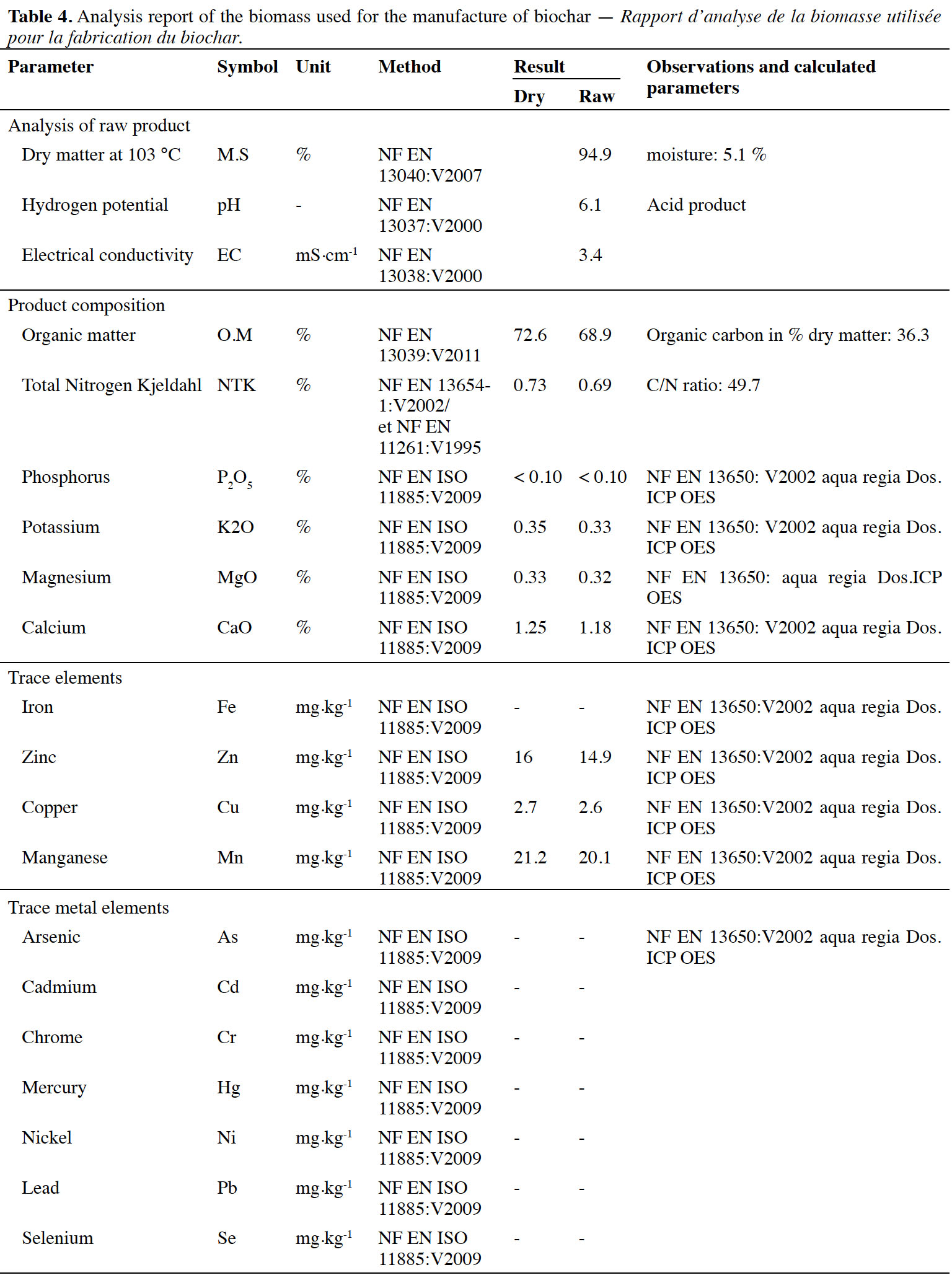
34Analysis results of certain soil parameters at the beginning and end of the experiment. Table 3 shows the analysis of certain soil parameters at the beginning and end of the experiment for different biochar treatments (0%, 1%, 2.5%, and 5%) :
35– EC: initially, the conductivity ranges from 800 µS·cm-1 to 1,830 µS·cm-1. By the end of the trial, conductivity decreases across all treatments, from 317 µS·cm-1 at 0% biochar to 523 µS·cm-1 at 5% biochar, though it remains higher for increased biochar levels.
36– OM: at the beginning, organic matter content is low, starting at 1.2% for both 0% and 1% treatments, and higher at 2.65% and 2.68% for 2.5% and 5% treatments, respectively. By the end, organic matter increases for all treatments, peaking at 2.7% for the 5% biochar addition.
37– CEC: initially, CEC varies slightly, ranging from 1.96 mg·100 g-1 to 3.46 mg·100 g-1, increasing with higher biochar application. At the end, CEC improves significantly, especially for higher biochar treatments, with the 5% biochar treatment reaching 88.4 mg·100 g-1.
38– Soil Water Retention Capacity: by the end of the experiment, water retention capacity increases for all treatments, rising from 45.7% for the 0% biochar treatment to 72.9% for the 5% treatment, indicating improved moisture retention with higher biochar levels.
39These results demonstrate that increasing biochar application enhances soil EC, OM, CEC, and water retention capacity, with the greatest improvements observed at the 5% biochar level.
40Effect of biochar on barley biomass and growth. Statistical analysis of the two trials conducted over two consecutive years highlighted the influence of biochar amendment rates on all growth and biomass production parameters of barley cultivated in sandy soil. The trials were carried out using an identical experimental design from one season to the next: the same soil type, the same barley variety, and the same open-air pot cultivation conditions. This approach allowed for the assessment of observed effects’reproducibility. Separate analysis of data from each season revealed similar trends across both years.
41Specifically, the application of date palm biochar at rates of 1% and 2.5% (by weight) did not result in any statistically significant differences compared to the control for parameters such as total fresh and dry biomass, root and shoot dry biomass, and grain yield (Figures 3 and 4) in both seasons. The best fresh and dry weights for the various parameters were observed at the 5% biochar treatment compared to the results from the unamended soil. Indeed, the 5% biochar treatment resulted in improvements in the total biomass production of barley of 80.41%, and 125.02% and 70.57% for the roots and the aerial part, respectively, compared to the control (Figures 3 and 4). The grain yield of barley also increased by 80% with the application of 5% biochar, compared to the unamended soil (Figures 3 and 4).
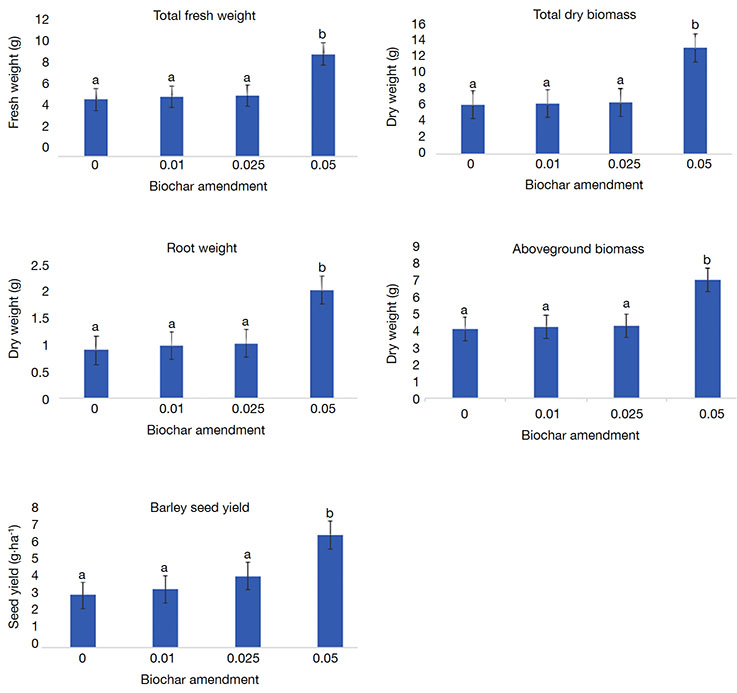
Figure 3. Effect of biochar-based treatments on development parameters of barley (1st season trial) — Effet des traitements à base de biochar sur les paramètres de développement de l’orge (essai de la 1ère campagne).
Means sharing identical letters within the same column do not exhibit significant differences at a significant level of 0.05 according to the SNK test — Les moyennes portant des lettres identiques dans une même colonne ne présentent pas de différences significatives au seuil de 0.05 selon le test SNK; ANOVA results for treatment factor effects: total fresh weight: df = 3, F = 30.49 and p < 0.001; total dry weight: df = 3, F = 15.78 and p < 0.001; root weight: df = 3, F = 41.46 and p < 0.001; aboveground biomass: df = 3, F = 11.89 and p < 0.00; Barley seed yield: df = 3, F = 79,04 and p < 0,001 — Résultats de l’ANOVA pour l’effet du facteur traitement : poids frais total : ddl = 3, F = 30,49 et p < 0,001 ; poids sec total : ddl = 3, F = 15,78 et p < 0,001 ; poids racinaire : ddl = 3, F = 41,46 et p < 0,001 ; biomasse aérienne : ddl = 3, F = 11,89 et p < 0,001 ; rendement en grains d’orge : ddl = 3, F = 79,04 et p < 0,001.
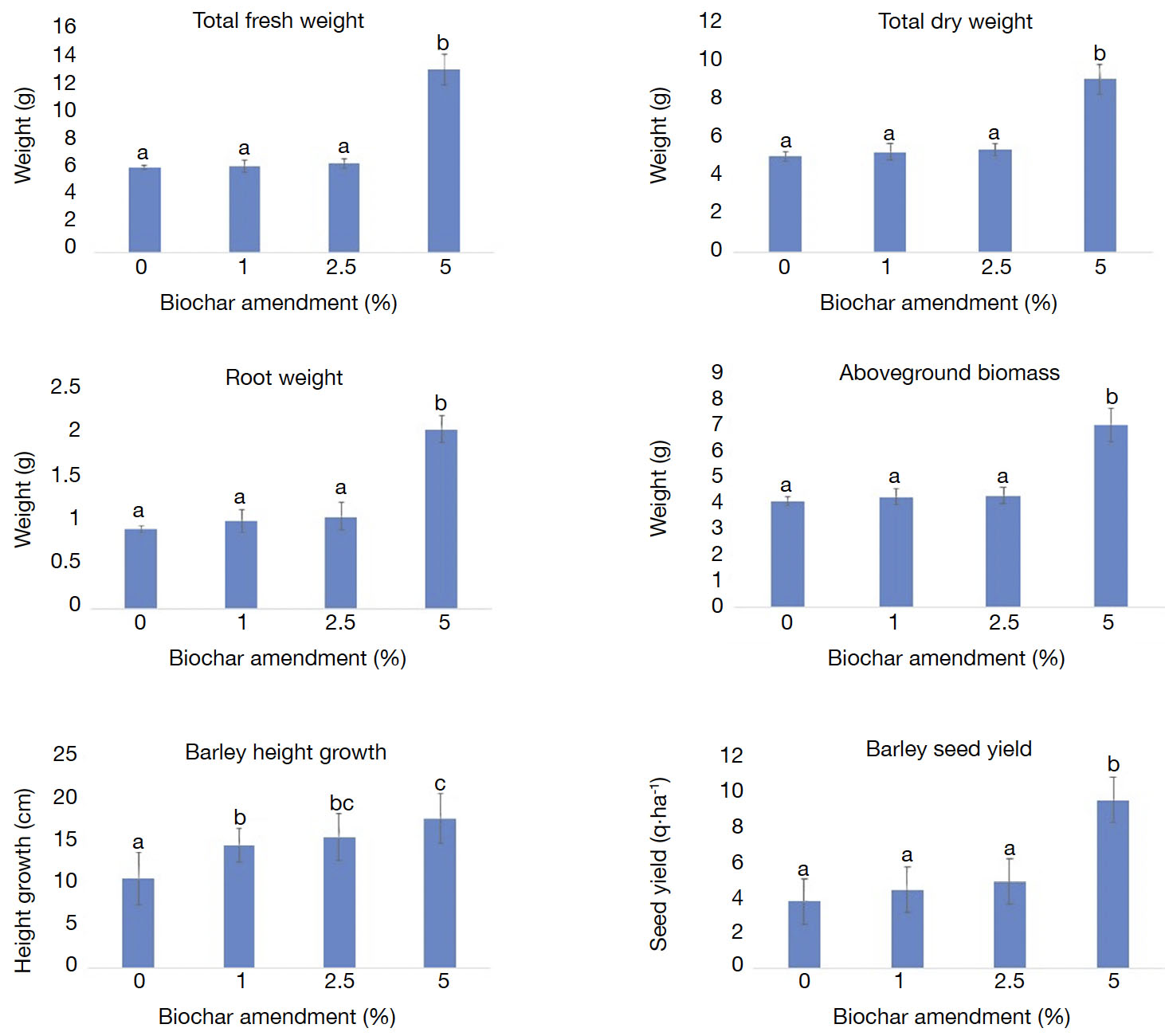
Figure 4. Effect of biochar-based treatments on the growth and development parameters of barley (2nd season trial) — Effet des traitements à base de biochar sur les paramètres de croissance et de développement de l’orge (essai de la 2è campagne).
Means sharing identical letters within the same column do not exhibit significant differences at a significant level of 0.05 according to the SNK test — Les moyennes partageant les mêmes lettres dans une même colonne ne présentent pas de différences significatives au seuil de signification de 0,05 selon le test SNK; ANOVA results for treatment factor effects: total fresh weight: df = 3, F = 59.49 and p < 0.001; total dry weight: df = 3, F = 27.32 and p < 0.001; root weight: df = 3, F = 41.46 and p < 0.00; aboveground biomass: df = 3, F = 18.72 and p < 0.00; barley height growth: df = 3, F = 41.64, p < 0.001 — Résultats de l’ANOVA pour les effets du facteur traitement : poids frais total : df = 3. F = 59.49 et p < 0.001 ; poids sec total : df = 3, F = 27,32 et p < 0,001 ; poids des racines : df = 3, F = 41,46 et p < 0,001 ; biomasse aérienne : df = 3, F = 18,72 et p < 0,001 ; croissance en hauteur de l’orge : df = 3, F = 41,64 et p < 0,001.
42These results suggest that a 5% biochar amendment rate constitutes an optimal threshold for enhancing the agronomic performance of barley in sandy soils, likely due to the physico-chemical properties of biochar that promote improved water retention and increased nutrient availability.
43These biomass increases are clearly demonstrated in figure 2, where the differences in crop development resulting from the various biochar application rates are shown both visually and quantitatively.
44Regarding barley height growth over two months, the analysis of the results showed that the application of 5% biochar to sandy soil increased barley height by 7.15 cm compared to the control.
45For the soil water retention capacity for each treatment, an increase is observed with higher biochar levels, indicating that treatments with higher concentrations of biochar improve the soil's ability to retain water (Figure 5).
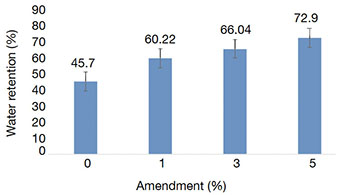
Figure 5. Effect of biochar amendment on soil water retention capacity — Effet de l’amendement en biochar sur la capacité de rétention en eau du sol.
46Analysis results of Barley leaves. The analysis of composite barley leaf samples showed that (Table 5):
47– nitrogen content in the leaves increases with the biochar amendment rate. At 0% biochar, the concentration is 1.78 mg·kg-1, gradually rising to 3.01 mg·kg-1 at 5% biochar in the soil. This indicates that the amendment enhances nitrogen availability for the plant, which can improve barley growth and yield.
48– available phosphorus, measured using the Olsen method, also follows an upward trend with increasing amendment rates. At 0%, the concentration is 0.18 mg·kg-1, increasing to 1.15 mg·kg-1 at 5% biochar. This suggests that biochar application improves phosphorus availability in the soil, which is essential for photosynthesis and root development in barley.
49– available potassium (K), measured in meq·100 g-1, also shows a slight increase with the amendment. At 0%, the concentration is 0.96 meq·100 g-1, reaching 1.48 meq·100 g-1 at 5% biochar. Although this increase is more modest compared to nitrogen and phosphorus, it still demonstrates a positive impact of the amendment on potassium availability, a key nutrient for water regulation and photosynthesis in plants.
4. Discussion
50The effect of biochar addition on soil and plant growth has been intensively studied in recent decades (Jones et al., 2012; Das et al., 2021; Lompo et al., 2021; Mounirou, 2022; Le Guyader et al., 2024). These studies encompass a wide range of parameters and variables, such as the type of biochar used, the application rate, the type of agricultural soil, the scale of experiments, and the species of the cultivated plant. In our study, amending sandy soil with biochar derived from date palm debris demonstrated several notable effects on soil properties and barley biomass production.
51The results of the biochar and biomass analyses (Tables 2 and 4) show that the biochar has a lower organic carbon content (29.72%) compared to the biomass used (36.3%). The electrical conductivity (EC) of the biochar is also higher (7.69 mS·cm-1) compared to that of the biomass (3.4 mS·cm-1). This increase can be attributed to the strong correlation between the EC of biochar and its ash content (70.28%) (Buss et al., 2016). Such ash-rich biochar is considered a good amendment for agricultural soils (Zhang et al., 2018).
52The pH of the biochar is alkaline (8.24) compared to the acidic pH of the biomass (6.1). This difference, as confirmed by Tahir et al. (2020), can be explained by the presence of alkaline (Na, K) or alkaline earth metals (Ca, Mg) in the form of carbonates, which are the main alkaline substances responsible for pH increase (Yuan et al., 2011). A positive correlation between the alkalinity of biochar and its ash content has also been demonstrated, as shown by previous research (Yuan et al., 2011). Accordingly, our biochar, with an ash content of 70.28%, supports these findings.
53The phosphorus, magnesium, and calcium contents are low in the biomass used but relatively high in the biochar. This trend can be explained by the decomposition of organic compounds in the biomass into volatile gases under the effect of pyrolysis temperature, while mineral compounds such as Mg, Ca, and P, which are much less volatile, remain in the biochar (Tan et al., 2017).
54The application of date palm biochar to the soil (Table 4) led to several notable effects. First, it significantly reduced soil EC across the different treatments. This can be attributed to the ability of biochar to enhance salt leaching, thereby lowering the electrical conductivity of the soil solution in the root zone (Yue et al., 2016). Second, a slight increase in soil organic matter content was observed. This limited change is likely due to the short duration of the barley crop cycle, which is insufficient for significant carbon mineralization of the biochar. Third, a notable increase in soil CEC was recorded with variations depending on the amendment rates. The highest CEC value, reaching 88.4 meq.100g-¹ with 5% biochar, represented an increase of 51.4 meq·100 g-1. This result exceeds previous findings on the impact of date palm frond biochar, which reported a CEC increase of only 6.7 meq·100 g-1 with the same biochar application rate (Tahir et al., 2020). The observed increase in CEC aligns with earlier studies which attribute this enhancement to the presence of oxygenated functional groups on the biochar surface (Tahir et al., 2020). Although the initial CEC of biochar is relatively low, it tends to increase over time as the material undergoes aging in the presence of oxygen and water (Cheng et al., 2008).
55Furthermore, other studies have demonstrated that biochar contributes to improvements in soil pH, nutrient availability, CEC, and water retention capacity (Tahir et al., 2020). These cumulative effects highlight the potential of date palm biochar as a valuable soil amendment in arid environments.
56The application of biochar also enhances soil water retention (Blanco-Canqui, 2017; Palai, 2020), although the effectiveness varies with soil texture. Sandy soils, in particular, show increased water retention following biochar application (Haddad, 2018). Research has demonstrated that date palm biochar increases the water retention capacity of sandy soils (Al-Shankiti & Gill, 2014). Our results corroborate these studies, showing a 60% increase in soil water retention with 5% date palm biochar compared to the control (Figure 5), compared to a 20% improvement reported by Tahir et al. (2020). Conversely, Le Guyader et al. (2024) reported an 80% increase in available water retention in a loamy-sandy soil enriched with 2/3 sand and amended with biochar compared to unamended soil. Therefore, the biochar amendment significantly improved the soil's hydraulic properties, as indicated by Laghari et al. (2015). Thus, the application of biochar derived from date palm residues appears to be a viable method for enhancing water retention in coarse-textured (sandy) soils and optimizing water resource use in irrigated areas (Le Guyader et al., 2024).
57Regarding its effect on barley cultivation, the incorporation of biochar derived from date palm residues into the soil had a significant impact on barley growth. While treatments with 1% and 2.5% biochar showed no notable differences compared to the control, the application of 5% biochar led to substantial biomass production, with an increase of 80.41% in total biomass and improvements of 125.02% and 70.57% in root and shoot biomass, respectively (Figures 3 and 4). Similarly, grain yield increased by 80% compared to the unamended soil. The improvements observed with 5% biochar are consistent with the findings of Jones et al. (2012), who reported that biochar application enhanced soil structure, water retention, and root development in barley, ultimately leading to increased biomass and grain yield.
58These enhancements can be attributed to biochar’s ability to stimulate root growth, promoting better water and nutrient uptake, which results in more vigorous plant development (Pandit et al., 2018). Additionally, biochar improves soil fertility by modifying pH and increasing nutrient availability, either through direct nutrient input or by enhancing nutrient retention and exchange in the soil (Karbout et al., 2019; Das et al., 2021). Another key factor is the improvement in cation exchange capacity (CEC) following the application of 5% biochar, with a 51.4% increase. Due to its porous structure, large surface area, and high CEC, biochar enhances soil quality, creating favorable conditions for plant growth (Glaser et al., 2002; Haddad, 2018). These findings align with previous studies highlighting biochar’s role in improving soil organic matter content, major cation availability, phosphorus content, and soil pH balance (Biederman & Harpole, 2013). Moreover, leaf analysis of barley revealed increased nitrogen (N), phosphorus (P), and potassium (K) concentrations, depending on the biochar amendment rate, indicating enhanced nutrient availability for plants.
59Similar results have been observed in other crops. For instance, the Kuwait Biochar Initiative demonstrated that applying date palm biochar to sandy soils led to a 55% increase in alfalfa biomass (Burezq et al., 2019). Likewise, Mounirou (2022) reported that onion yield tripled with biochar application alone and quadrupled when combined with goat manure.
60Despite these promising results, some studies have reported negative effects of biochar on agricultural yields following its incorporation into the soil (Deenik et al., 2010). These discrepancies may be linked to variations in pyrolysis conditions and application rates which strongly influence biochar effectiveness. Alotaibi & Schoenau (2019) observed a reduction in wheat shoot biomass when date palm biochar was produced at temperatures exceeding 400 °C, whereas productivity increased when biochar was applied in combination with fertilizers and produced at lower temperatures. Similarly, Le Guyader et al. (2025) found that biochar produced at 450 °C, applied alone or with a nutrient source, tended to reduce barley shoot biomass and grain yield in the short term.
61Le Guyader et al. (2024) also reported that an application rate of 10 t·ha-1 had no significant effect on yield or nutrient uptake, with a slight downward trend compared to unamended soils.
62A comparison with the average barley yield in the Tafilalet region further highlights these variations. Under controlled pot conditions, using biochar from the same biomass led to an 80.41% increase in total biomass and an 80% rise in grain yield with 5% biochar compared to the control. Although these results confirm those of Biederman & Harpole (2013) and Najafi-Ghiri et al. (2019) regarding biochar’s potential to enhance barley productivity, the obtained yield remains below the expected average in Tafilalet (14.07 qx·ha-1, according to the Haut-Commissariat au Plan, [2021]). These findings suggest that biochar application alone may not be sufficient to significantly optimize barley yield in this region.
63Biochar’s effectiveness in agricultural systems is influenced by several factors, including soil type, feedstock used for biochar production, biochar type and application rate and environmental conditions (Barnes et al., 2014). Therefore, further field-scale research is needed to better understand the variability in biochar’s effects on crops and to determine optimal application strategies.
64Finally, the combination of biochar and date palm compost presents a promising approach for ensuring sustainable agricultural productivity in oasis ecosystems. These two amendments are complementary: biochar, as a source of recalcitrant organic matter, improves soil physical properties (Blanco-Canqui, 2017), while compost supplies readily available nutrients and enhances soil microbial activity (Malou et al., 2020).
5. Conclusions
65The results of our study indicate that amending sandy soil with biochar derived from date palm debris improved the soil's physical and chemical properties and enhanced barley productivity at a 5% amendment rate. The study, conducted in a pot experiment in southeastern Morocco, revealed that biochar application increased soil organic matter content, improved electrical conductivity and cation exchange capacity by 51,4 meq·100 g-1. It also improved soil water retention capacity by 60% compared to unamended soil. These positive effects on soil parameters notably contributed to increasing dry biomass production and grain yield of barley by 80.5% and 80%, respectively, compared to unamended soil.
66Although this study has certain limitations, it provides valuable insights into the impact of biochar on soil properties and barley cultivation. Given the complementary roles of biochar and compost, it would be relevant to conduct further amendment trials under real conditions, on different soil types, and across various pedoclimatic conditions of the oasis system.
67The valorization of date palm debris into biochar also represents an innovative and viable technique for transforming residues into a valuable soil amendment, offering benefits in soil fertility, improved hydraulic properties, and mitigating environmental risks in oasis ecosystems through better management of date palm debris. Given its long-term stability in the soil, date palm biochar holds significant potential to enhance the resilience of the oasis system.
Bibliographie
Agegnehu G., Srivastava A.K. & Bird M.I., 2017. The role of biochar and biochar-compost in improving soil quality and crop performance: a review. Appl. Soil Ecol., 119, 156-170, doi.org/10.1016/j.apsoil.2017.06.008
Alotaibi K.D. & Schoenau J.J., 2019. Addition of biochar to a sandy desert soil: effect on crop growth, water retention and selected properties. Agronomy, 9, 327, doi.org/10.3390/agronomy9060327
Al-Shankiti A. & Gill S., 2014. Biochar for improvement of soil quality: a comparative study. Biosalinity News, 15, 8-9.
Al-Wabel M.I. et al., 2019. Date palm waste biochars alter soil respiration, microbial biomass carbon, and heavy metal mobility in contaminated mined soil. Environ. Geochem. Health, 41, 1705-1722, doi.org/10.1007/s10653-017-9955-0
Bacyé B., Kambiré H.S., Sawadogo M.O. & Zonga A.M., 2021. Effets des modes de gestion des résidus du bananier et d’options de fumure minérale sur le rendement du maïs et les caractéristiques chimiques du sol dans un système de rotation bananier/maïs à l’Ouest du Burkina Faso. Int. J. Biol. Chem. Sci., 15, 1208-1221, doi.org/10.4314/ijbcs.v15i3.26
Badawi M.A., 2019. Production of biochar from date palm fronds and its effects on soil properties. Mater. Res. Proc., 11, 159-168, doi.org/10.21741/9781644900178-11
Barnes R.T. et al., 2014. Biochar-induced changes in soil hydraulic conductivity and dissolved nutrient fluxes constrained by laboratory experiments. Plos One, 9, e108340, doi.org/10.1371/journal.pone.0108340
Biederman L.A. & Harpole W.S., 2013. Biochar and its effects on plant productivity and nutrient cycling: a meta-analysis. Global Change Biol., 5, 202-214, doi.org/10.1111/gcbb.12037
Blanco-Canqui H., 2017. Biochar and soil physical properties. Soil Sci. Soc. Am. J., 81, 687-711, doi.org/10.2136/sssaj2017.01.0017
Burezq H. et al., 2019. Development of nutritional and biodegradable product to improve stability and fertility of sandy soil. Progress Report. Safa, Kuwait: Kuwait Institute for Scientific Research.
Burezq H.A. & Davidson M.K., 2023. Biochar from date palm (Phoenix dactylifera L.) residues-a critical review. Arabian J. Geosci., 16, 101, doi.org/10.1007/s12517-022-11123-0
Buss W., Graham M.C., Shepherd J.G. & Mašek O., 2016. Suitability of marginal biomass-derived biochars for soil amendment. Sci. Total Environ., 547, 314-322, doi.org/10.1016/j.scitotenv.2015.11.148
Busscher W.J. et al., 2010. Influence of pecan biochar on physical properties of a Norfolk loamy sand. Soil Sci., 175, 10-14, doi.org/10.1097/SS.0b013e3181cb7f46
Cheng C.H., Lehmann J. & Engelhard M.H., 2008. Natural oxidation of black carbon in soils: changes in molecular form and surface charge along a climosequence. Geochim. Cosmochim. Acta, 72, 1598-1610, doi.org/10.1016/j.gca.2008.01.010
Clouet Y., 1995. Les oasis. Mappemonde, 4, 44-48.
Cornelissen G. et al., 2016. Emissions and char quality of flame-curtain “Kon Tiki” kilns for farmer-scale charcoal/biochar production. Plos one, 11, e0154617, doi.org/10.1371/journal.pone.0154617
Das S.K., Ghosh G.K., Avasthe R.K. & Sinha K., 2021. Compositional heterogeneity of different biochar: effect of pyrolysis temperature and feedstocks. J. Environ. Manage., 278, 111501, doi.org/10.1016/j.jenvman.2020.111501
Deenik J.L. et al., 2010. Charcoal volatile matter content influences plant growth and soil nitrogen transformations. Soil Sci. Soc. Am. J., 74, 1259-1270, doi.org/10.2136/sssaj2009.0115
El Janati M. et al., 2021. Benefits of circular agriculture for cropping systems and soil fertility in oases. Sustainability, 13, 4713, doi.org/10.3390/su13094713
Fallahzade J. & Hajabbasi M.A., 2012. The effects of irrigation and cultivation on the quality of desert soil in central Iran. Land Degrad. Dev., 23, 53-61, doi.org/10.1002/ldr.1049
Fearnside P.M., 2000. Global warming and tropical land-use change: greenhouse gas emissions from biomass burning, decomposition and soils in forest conversion, shifting cultivation and secondary vegetation. Clim. Change, 46, 115-158, doi.org/10.1023/A:1005569915357
Glaser B., Lehmann J. & Zech W., 2002. Ameliorating physical and chemical properties of highly weathered soils in the tropics with charcoal-a review. Biol. Fertil. Soils, 35, 219-230.
Haddad K., 2018. Étude de la pyrolyse de matériaux biosourcés chimiquement modifiés : caractérisation des biochars et application agronomique. Thèse de doctorat : Université de Haute Alsace, Mulhouse (France) ; Institut National Agronomique de Tunisie, Tunis (Tunisie).
Haut-Commissariat au Plan, 2021. Note d’information du Haut-Commissariat au Plan relative à la situation du marché du travail en 2020. Rabat : HCP, https://www.hcp.ma/La-situation-du-marche-du-travail-en-2020_a2650.html, (18/06/2025).
Jeffery S., Verheijen F.G., van der Velde M. & Bastos A.C., 2011. A quantitative review of the effects of biochar application to soils on crop productivity using meta-analysis. Agric. Ecosyst. Environ., 144, 175-187, doi.org/10.1016/j.agee.2011.08.015
Jimin S., Zhongli D. & Tungsheng L., 1998. Desert distributions during the glacial maximum and climatic optimum: example of China. Episodes J. Int. Geosci., 21, 28-31, doi.org/10.18814/epiiugs/1998/v21i1/005
Jones D.L. et al., 2012. Biochar-mediated changes in soil quality and plant growth in a three-year field trial. Soil Biol. Biochem., 45, 113-124, doi.org/10.1016/j.soilbio.2011.10.012
Karbout N. et al., 2019. Applying biochar from date palm waste residues to improve the organic matter, nutrient status and water retention in sandy oasis soils. J. Res. Environ. Earth Sci., 7, 203-209.
Khardi A., Nogot A., Abdellaoui M. & Jaiti F., 2024. Valorisation des sous-produits du palmier-dattier pour contribuer à la durabilité des oasis du Maroc. Cah. Agric., 33, 3, doi.org/10.1051/cagri/2023027
Kinney T.J. et al., 2012. Hydrologic properties of biochars produced at different temperatures. Biomass Bioenergy, 41, 34-43, doi.org/10.1016/j.biombioe.2012.01.033
Laghari M. et al., 2015. Influence of biochar on sandy soil hydraulic properties and nutrient leaching. J. Hydrol. Hydromech., 63, 26-32.
Lal R., 2004. Carbon sequestration in dryland ecosystems. Environ. Manage., 33, 528-544, doi.org/10.1007/s00267-003-9110-9
Le Guyader E. et al., 2024. Influence of date palm-based biochar and compost on water retention properties of soils with different sand contents. Forests, 15, 304, doi.org/10.3390/f15020304
Le Guyader E. et al., 2025. Nitrogen budget and barley response to organic amendments in a sandy soil under simulated arid climate. Soil Use Manage., 41, e70008, doi.org/10.1111/sum.70008
Lehmann J. & Joseph S., eds, 2015. Biochar for environmental management: an introduction. Routledge.
Lompo D.J.P., Yé L., Balboné B. & Sori S.I., 2021. Effets combinés du biocharbon et du fumier sur les propriétés physico-chimiques d’un sol ferrugineux tropical sous culture de mil en zone semi-aride du Burkina Faso. J. Appl. Biosci., 157, 16161-16181, doi.org/10.35759/JABs.157.3
Malou O. et al., 2020. The Rock-Eval® signature of soil organic carbon in arenosols of the Senegalese groundnut basin. How do agricultural practices matter? Agric. Ecosyst. Environ., 301, 107030, doi.org/10.1016/j.agee.2020.107030
Marinos S. et al., 2022. Biochar production from the pyrolysis of tomato processing residues. In: Tomato processing by-products. Academic Press, 171-200, doi.org/10.1016/B978-0-12-822866-1.00002-8
Mounirou M.M., 2022. Effet comparé de la fertilisation à base de biochar, engrais organique et engrais chimique sur les éléments minéraux et la production de l’oignon (Allium cepa L.). Eur. Sci. J., 18, 47-67, doi.org/10.19044/esj.2022.v18n24p47
Najafi-Ghiri M., Razeghizadeh T., Taghizadeh M.S. & Boostani H.R., 2019. Effect of sheep manure and its produced vermicompost and biochar on the properties of a calcareous soil after barley harvest. Commun. Soil Sci. Plant Anal., 50, 2610-2625, doi.org/10.1080/00103624.2019.1671444
ORMVA-TF, 2023. Bilan phoenicicole de l'Office Régional de Mise en Valeur Agricole du Tafilalet (ORMVA-TF). Rapport annuel. Errachidia, Maroc : ORMVA-TF.
Palai J.B., 2020. Role of biochar in sustainable agriculture. Agro Economist, 7, 73-75.
Pandit N.R., Mulder J. & Cornelissen G., 2018. Biochar improves maize growth by alleviation of nutrient stress in a moderately acidic low-input Nepalese soil. Sci. Total Environ., 625, 1380-1389, doi.org/10.1016/j.scitotenv.2018.01.022
Shafie S.T. et al., 2012. Effect of pyrolysis temperature on the biochar nutrient and water retention capacity. J. Purity Util. React. Environ., 1, 323-337.
Tahir A.H., Al-Obaidy A.H.M. & Mohammed F.H., 2020. Biochar from date palm waste, production, characteristics and use in the treatment of pollutants: a review. IOP Conf. Ser.: Mater. Sci. Eng., 737, 012171, doi.org/10.1088/1757-899X/737/1/012171
Tan X.F. et al., 2017. Biochar as potential sustainable precursors for activated carbon production: multiple applications in environmental protection and energy storage. Bioresour. Technol., 227, 359-372, doi.org/10.1016/j.biortech.2016.12.083
Temmerman M., Andrianirina R. & Richter F., 2019. Performances techniques et environnementales du four de carbonisation Green Mad Retort à Madagascar. Bois For. Trop., 340, 43-55, doi.org/10.19182/bft2019.340.a31700
Van Asperen H.L. et al., 2014. Properties of anthropogenic soils in ancient run-off capturing agricultural terraces in the Central Negev desert (Israel) and related effects of biochar and ash on crop growth. Plant Soil, 374, 779-792, doi.org/10.1007/s11104-013-1901-z
Wang T., Arbestan M.C., Hedley M. & Bishop P., 2012. Predicting phosphorus bioavailability from high-ash biochars. Plant Soil, 357, 173-187, doi.org/10.1007/s11104-012-1131-9
Wang B., Gao B. & Fang J., 2017. Recent advances in engineered biochar productions and applications. Crit. Rev. Environ. Sci. Technol., 47, 2158-2207.
Xiong X., He M., Dutta S. & Tsang D.C., 2022. Biochar and sustainable development goals. In: Biochar in agriculture for achieving sustainable development goals. Academic Press, 15-22.
Yuan J.H., Xu R.K. & Zhang H., 2011. The forms of alkalis in the biochar produced from crop residues at different temperatures. Bioresour. Technol., 102, 3488-3497, doi.org/10.1016/j.biortech.2010.11.018
Yue Y. et al., 2016. Improving salt leaching in a simulated saline soil column by three biochars derived from rice straw (Oryza sativa L.), sunflower straw (Helianthus annuus), and cow manure. J. Soil Water Conserv., 71, 467-475, doi.org/10.2489/jswc.71.6.467
Zhang Z. et al., 2018. Experiments and modelling of potassium release behavior from tablet biomass ash for better recycling of ash as eco-friendly fertilizer. J. Cleaner Prod., 170, 379-387, doi.org/10.1016/j.jclepro.2017.09.150






